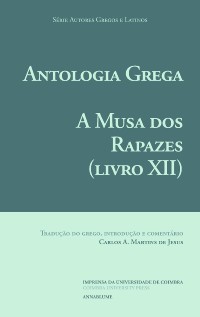Please use this identifier to cite or link to this item:
https://hdl.handle.net/10316.2/41182| DC Field | Value | Language |
|---|---|---|
| dc.contributor.author | Jesus, Carlos A. Martins de | por |
| dc.date.accessioned | 2017-03-20T15:17:25Z | |
| dc.date.accessioned | 2020-03-15T20:38:51Z | - |
| dc.date.available | 2017-03-20T15:17:25Z | |
| dc.date.available | 2020-03-15T20:38:51Z | - |
| dc.date.issued | 2017 | - |
| dc.identifier.isbn | 978-989-26-1333-8 | por |
| dc.identifier.isbn | 978-989-26-1334-5 (PDF) | por |
| dc.identifier.uri | https://hdl.handle.net/10316.2/41182 | por |
| dc.description.abstract | Book XII of the Greek Anthology, the one this volume first offers in Portuguese translation, gathers around 260 epigrams united by the homoerotic subject they all develop. Besides a small group of components devoted to heterosexual love, erroneously included in the collection by scribers and here translated as well, they all deal with the model of a love-relationship between an adult (the so-called erastes, the top-lover) and a teenager (the eromenos, supposed to be the bottom). The Boyish Muse’s immediate parallel is Book five of the Greek Antholoy, devoted to heterosexual love. Nonetheless, a first reading of both of them sheds light on their similarities, enhancing several common topics and images, themselves prove enough of a same reality that is celebrated – both the joys (rather few) and the (many) pains of love. | eng |
| dc.description.abstract | O Livro XII da Antologia Grega, que neste volume pela primeira vez se traduz completo em língua portuguesa, contempla cerca de 260 epigramas unidos pela temática homoerótica que desenvolvem. À parte um conjunto escasso de componentes dedicados ao amor heterossexual, erroneamente introduzidos pelos copistas na coleção e que aqui são também traduzidos, versam sobre o modelo da relação amorosa entre um homem adulto (o assim designado erastes, o “amante” que sexualmente exercia a posição de ativo) e um adolescente (o eromenos), que se supunha dever assumir o papel de passivo. A Musa dos rapazes tem, como contraponto imediato, o livro V da Antologia, coletânea mais extensa de epigramas sobre o amor heterossexual. Uma leitura de ambos permite no entanto, em primeira instância, detetar um grupo de tópicos e imagens que se repetem, prova em si de que ambos celebram uma mesma realidade – as benesses (mais bem escassas) e as agruras do amor. | por |
| dc.language.iso | por | por |
| dc.publisher | Imprensa da Universidade de Coimbra | por |
| dc.rights | open access | por |
| dc.subject | Greek Anthology | eng |
| dc.subject | Strato | eng |
| dc.subject | epigram | eng |
| dc.subject | homoerotism | eng |
| dc.subject | Antologia Grega | por |
| dc.subject | Estratão | por |
| dc.subject | epigrama | por |
| dc.subject | homoerotismo | por |
| dc.title | Antologia Grega: a Musa dos Rapazes (livro XII) | por |
| dc.title.alternative | Greek Anthology: the Boyish Muse (book XII) | eng |
| dc.type | book | por |
| uc.publication.location | Coimbra | por |
| dc.identifier.doi | 10.14195/978-989-26-1334-5 | por |
| uc.publication.digCollection | PB | por |
| uc.publication.area | Artes e Humanidades | por |
| uc.publication.manifest | https://dl.uc.pt/json/iiif/10316.2/41182/149668/manifest?manifest=/json/iiif/10316.2/41182/149668/manifest | - |
| uc.publication.thumbnail | https://dl.uc.pt/retrieve/8255321 | - |
| uc.itemId | 54668 | - |
| item.grantfulltext | open | - |
| item.fulltext | With Fulltext | - |
| Appears in Collections: | Pombalina | |
Files in This Item:
| File | Description | Size | Format | |
|---|---|---|---|---|
| antologia_grega_a_musa_dos_rapazes.pdf | 854.04 kB | Adobe PDF |  |
Items in DSpace are protected by copyright, with all rights reserved, unless otherwise indicated.
